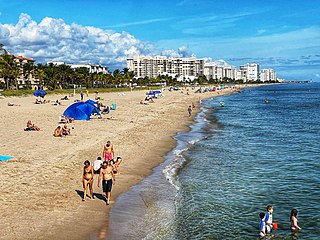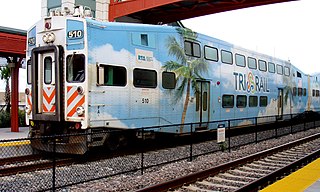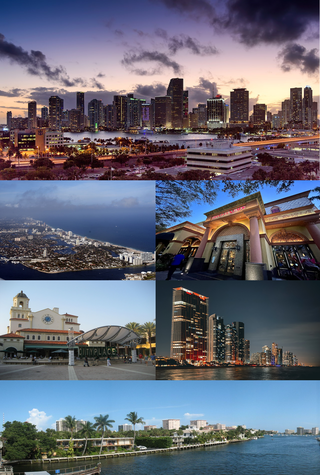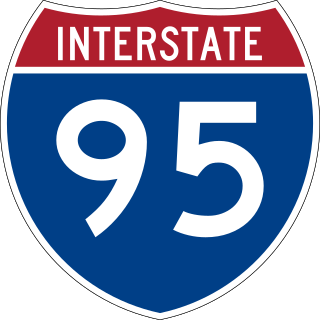
Fort Lauderdale is a coastal city located in the U.S. state of Florida, 30 miles (48 km) north of Miami along the Atlantic Ocean. It is the county seat of and largest city in Broward County with a population of 182,760 at the 2020 census, making it the tenth largest city in Florida. After Miami, Fort Lauderdale is the second principal city in the Miami metropolitan area, which had a population of 6,166,488 in 2019.

Lauderdale-by-the-Sea is a town in Broward County, Florida, United States, situated 33 miles north of Miami. As of the 2020 census, the population was 6,198. It is part of the Miami–Fort Lauderdale–West Palm Beach Metropolitan Statistical Area, which was home to 5,564,635 people at the 2010 census.

Plantation is a city in Broward County, Florida, United States. As of the 2020 U.S. census, the population was 91,750. The city's name comes from the previous part-owner of the land, the Everglades Plantation Company, and their unsuccessful attempts to establish a rice plantation in the area.

Wilton Manors is a city in Broward County, Florida, United States. As of the 2020 census, the city had a population of 11,426. Wilton Manors is part of the Miami metropolitan area, which was home to 6,166,488 people at the 2020 census.

Fort Lauderdale–Hollywood International Airport is a major public airport in Broward County, Florida, United States. It is one of three airports serving the Miami metropolitan area. The airport is off Interstate 595, Interstate 95, U.S. Route 1, Florida State Road A1A, and Florida State Road 5 bounded by the cities Fort Lauderdale, Hollywood, and Dania Beach, 3 miles (5 km) southwest of downtown Fort Lauderdale and 21 miles (34 km) north of Miami.

Lockhart Stadium was a stadium used mostly for soccer in Fort Lauderdale, Florida, United States. It was used in a variety of sports, particularly soccer and American football.

Tri-Rail is a commuter rail line linking Miami, Fort Lauderdale and West Palm Beach in Florida, United States. The Tri prefix in the name refers to the three counties served by the railroad: Palm Beach, Broward, and Miami-Dade. Tri-Rail is managed by the South Florida Regional Transportation Authority (SFRTA) along CSX Transportation's former Miami Subdivision; the line is now wholly owned by the Florida DOT. The 70.9-mile-long (114.1 km) system has 18 stations along the Southeast Florida coast, and connects directly to Amtrak at numerous stations, and to Metrorail at the Tri-Rail and Metrorail Transfer station and at Miami Intermodal Center.
Florida's Turnpike, designated as unsigned State Road 91, is a toll road in the U.S. state of Florida, maintained by Florida's Turnpike Enterprise (FTE). Spanning approximately 309 miles (497 km) along a northwest–southeast axis, the turnpike is in two sections. The SR 91 mainline runs roughly 265 miles (426 km), from its southern terminus at an interchange with Interstate 95 (I-95) in Miami Gardens to an interchange with I-75 in Wildwood at its northern terminus. The Homestead Extension of Florida's Turnpike continues from the southern end of the mainline for another 48 miles (77 km) to US Highway 1 in Florida City. The slogan for the road is "The Less Stressway". The mainline opened in stages between 1957 and 1964, while the extension was completed in 1974. The turnpike runs through Miami, Fort Lauderdale, and West Palm Beach, where it parallels I-95, and through Orlando, where it crosses I-4.

The Florida East Coast Railway is a Class II railroad operating in the U.S. state of Florida, currently owned by Grupo México.

The Miami metropolitan area is the ninth-largest metropolitan statistical area in the United States and the 65th-largest metropolitan area in the world with a 2020 population of 6.138 million people.

The Francis Scott Key Bridge, also known originally as the Outer Harbor Crossing or simply as the Key Bridge or Beltway Bridge, is a steel arch-shaped continuous through truss bridge spanning the lower Patapsco River and outer Baltimore Harbor / Port in Baltimore, Maryland, United States. The main span of 1,200 feet (366 m) is the third longest span of any continuous truss in the world. It is also the longest bridge in the Baltimore metropolitan area.

Interstate 95 (I-95) is the main Interstate Highway of Florida's Atlantic Coast. It begins at a partial interchange with US Highway 1 (US 1) just south of downtown Miami and heads north through Jacksonville, and to the Georgia state line at the St. Marys River near Becker. The route also passes through the cities of Fort Lauderdale, West Palm Beach, Port St. Lucie, Titusville, and Daytona Beach.

State Road 732 (SR 732) comprises two segments of a state highway in the Jensen Beach, Florida vicinity. The western 2.2-mile-long (3.5 km) segment is a part of Jensen Beach Boulevard between U.S. Route 1 (US 1) and County Road 723 (CR 723) and CR 707A. The eastern 1.9-mile-long (3.1 km) segment consists of Causeway Boulevard and the Jensen Beach Causeway over the Indian River Lagoon and runs between CR 707 and SR A1A.
The Conrad Fort Lauderdale is a luxury condominium-hotel resort located on ocean-front property on North Fort Lauderdale Beach Boulevard in Fort Lauderdale, Florida. The resort includes 181 condo-hotel units, as well as 109 condominium units in a separate building known as The Ocean Resort Residences. The project initially began construction in July 2005, as Trump International Hotel & Tower Fort Lauderdale. Donald Trump lent his name to the project through a licensing deal before being elected the President of the United States, with New York developer Roy Stillman and Bayrock Group as the project developers. The project's opening was initially scheduled for 2007, but was delayed several times.

The New River is a tidal estuary in South Florida, United States. Despite its name, it is not a river, but a channel composed of many tributary canals, The channel is connected to the Everglades through a series of man-made canals. After passing through Fort Lauderdale, the channel connects to the Intracoastal Waterway and Atlantic Ocean at Port Everglades cut. The channel is entirely within Broward County and is composed from the junction of three main canals which originate in the Everglades, splitting off from the Miami Canal. They are the North New River Canal, which flows south from Lake Okeechobee along the east side of U.S. 27 and then east along the north side of State Road 84 / Interstate 595; the South New River Canal, which flows east from the Miami Canal along the north side of Griffin Road and the south side of Orange Drive; and a canal which flows east along the south side of Sunrise Boulevard.

The Snow-Reed Swing Bridge is one of the oldest bridges in the Fort Lauderdale area, and one of the few remaining swing bridges in Florida. Located between the 300 and 500 block of Southwest 11th (Palm) Avenue in Fort Lauderdale, Florida, the bridge connects the neighborhoods of Sailboat Bend and Riverside Park. In 1989 it was officially renamed and designated a historic landmark.

The Greater Miami area, composed of the three counties of Miami-Dade, Broward, and Palm Beach, also known collectively as South Florida, is home to a wide variety of public and private transportation systems. These include heavy rail mass transit (Metrorail), commuter rail (Tri-Rail), automated guideway transit (Metromover), highways, two major airports and seaports, as well as three county-wide bus networks, which cover the entire urbanized area of South Florida. Census and ridership data show that Miami has the highest public transportation usage of any city in Florida, as about 17% of Miamians use public transportation on a regular basis, compared to about 4% of commuters in the South Florida metropolitan area. The majority of public transportation in Miami is operated by Miami-Dade Transit (MDT), which is currently the largest transit system in Florida and was the 14th largest transit system in the United States in 2011.

Brightline is an inter-city rail route between Miami and West Palm Beach, Florida. It runs on track owned by Florida East Coast Railway.

The Seaboard–All Florida Railway was a subsidiary of the Seaboard Air Line Railroad that oversaw two major extensions of the system in the early 1920s to southern Florida on each coast during the land boom. One line extended the Seaboard's tracks on the east coast from West Palm Beach down to Fort Lauderdale and Miami, while the other extension on the west coast extended the tracks from Fort Ogden south to Fort Myers and Naples, with branches from Fort Myers to LaBelle and Punta Rassa. These two extensions were heavily championed by Seaboard president S. Davies Warfield, and were constructed by Foley Brothers railroad contractors. Both extensions also allowed the Seaboard to better compete with the Florida East Coast Railway and the Atlantic Coast Line Railroad, who already served the lower east and west coasts of Florida respectively.
The following is a timeline of the history of the city of Fort Lauderdale, Florida, USA.

















